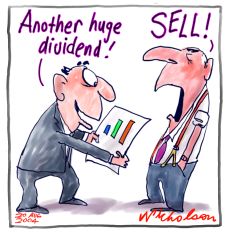I invest in the stock market for dividend income. It wasn’t always that way, but these days I’m more interested in getting on with other aspects of my life than worrying about my stock portfolio.
I thought you’d be interested in the actual method I use to pick which dividend stocks to invest in. So this post is that.
It shouldn’t be a long post. To be honest, the whole strategy is actually super simple and way less complicated than when I was investing for growth.
Once I pick the stocks I generally don’t even look at them again until I do a portfolio rebalance which I only do once a year. Other than that it’s really set and forget. Oh, and look forward to those regular cash deposits into my bank account.
Why Invest for the Dividend?
Investing for the dividend is a simpler way to invest in stocks. All you care about is how much of the company profits that you are going to get back each payout.
That means less worry about whether the stock price is up or down, or what the market is doing overall. You get paid the dividend whatever the price is or what the market is doing.
Share price has fallen? So what, that dividend deposit is about to land in your bank account next week anyway. And it’ll do the same the next time dividends come around again too.
Plus, and the main reason, is that the more you can get back from the stock market in income, the more money you’ll have for your day to day expenses.
It also means that you can effectively retire early if you were able to build up a big enough portfolio to do so. All those stories of people retiring in their 30’s and 40’s. Yeah, you can do that by dividend investing. Cool, right?
So What Do I Look For?
There are three main factors that I look for when I’m choosing which stocks to invest in for the dividend income.
- The first is that I usually stick with the biggest companies. So those in the ASX200 (the equivalent in the US is the S&P500). The reason for this is generally because they are less riskier than smaller cap stocks.
Small capitalisation stocks can be good for quick growth, but they generally aren’t always great dividend payers.
Go for the more estabilished companies on the stock exchange
- The second thing I look for is a decent yield. Generally, that’s a figure of over 5%. Most of the dividend stocks I own have yields between five and seven percent. I do have a few slightly under or over that though.
Sectors that tend to have higher yields are the financial sectors, utilities, and sometimes consumer staples sector.
You can find the yield on any company research page.
If the company has a good yield AND it has franked dividends, that’s even better because those tax credits add up and, depending on your tax bracket, will either lower the tax you pay or sometimes even mean a sweet refund.
- The third thing is to make sure that those dividends are nice and stable. That is, that the company pays at regular intervals each year
and that the payout is stable and, preferably, growing.
You can find this out by going to the dividend page for the company that you’re looking at investing in and checking the dividend history.
- Finally, just think about what the company does and whether you can predict whether it’ll still be around in the future. Some companies are more likely to weather the storm of technology changes and personal lifestyle shifts than others.
This one won’t be on any company balance sheet, it’s more just using your brain about whether you see the company thriving in the future or not. Just go and see what the company does. Banks will likely be around in the future, a company with old technology might not.
If you want more detail on any of these factors, I show specific examples in my book Take My Dividend Strategy.
Things To Be Aware Of
While doing the research on which stocks to invest in, mostly it’s pretty straightforward, however, like everything, there are things to be aware of that can skew the numbers.
This is just a quick list to be mindful of:
- There will be changes to the stock price over the dividend payout cycle. This is especially evident on ex-dividend day when the stock price will fall. Don’t worry, it’s just investors who used a dividend stripping strategy and are pulling their money out. The price will go back up within a few weeks to a few months (unless the market or company is bearish).
- Dividend yield can be inflated by a lower stock price. If the company is in a downtrend, the yield will look artificially higher. Make sure that if a yield looks high to check whether it’s in a downtrend first and then look at the dividend history page.
- Special one-off dividends aren’t included in the dividend yield but will be shown on the dividend history page. When looking at stability, you can safely ignore these outlier payments when determining how regular the dividends are.
- Yield only tells part of the story. Don’t rely on it alone when choosing what to invest in. Look at the other factors too.
- You don’t have to choose only dividend stocks in your portfolio. You can have a mix of growth and income stocks.
- Decide whether to participate in the DRIP (Dividend Reinvestment Program) based on what stage of investing you’re at – growth or income.
I hope you’ve found this post useful. Good luck with your own investing, and let me know if you prefer a growth or income based portfolio.
Tracey 🙂
Cover Photo by rawpixel on Unsplash



